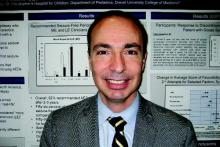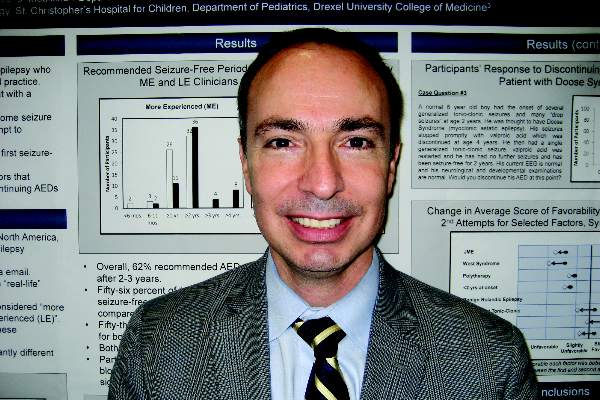User login
SEATTLE – Pediatric epileptologists require a longer seizure-free duration when it comes to a second attempt at discontinuing antiepileptic drugs (AEDs) in epileptic children after a failed first attempt, new data show.
Researchers conducted a survey by e-mail of 94 U.S. and Canadian pediatric epileptologists in 2014, asking about their usual approach to weaning patients off AEDs. Additionally, they presented the epileptologists with real-life cases in which discontinuation of AEDs might be more difficult.
Main results reported in a poster session at the annual meeting of the American Epilepsy Society showed that a majority of epileptologists required that children have a seizure-free period of 2-3 years before a first attempt at discontinuation (62%) and before a second attempt at discontinuation (62%), although there was considerable variability.
Overall, there was a shift toward a longer required seizure-free period going from a first to a second attempt: the proportion of epileptologists requiring less than 2 years fell from 38% to 21%, while the proportion requiring 3 or more years rose from 0% to 17%.
This shift was greater among those who were more experienced, defined as having practiced pediatric epilepsy for at least 10 years after finishing their fellowship: 56% of these more experienced epileptologists required a longer duration the second time, compared with 26% of less experienced epileptologists.
“There is a lot of disagreement how people do this [discontinue AEDs on the second attempt],” presenting researcher Dr. Ignacio Valencia, an attending neurologist and associate professor of pediatrics at St. Christopher’s Hospital for Children, Philadelphia, commented in an interview. “Epileptologists in general are more cautious the second time, and even more so the people who have more experience compared to the less experienced.”
“There are no guidelines or statements from the American Epilepsy Society about how to wean down the second time,” he added. The next step will be to analyze the characteristics of second attempts and patients outcomes. “Then we could try to make a consensus statement from one of the epilepsy societies, like a recommendation for people who treat children with epilepsy, how to do it the second time.”
The more experienced epileptologists likely wait longer because “they have just been burned before. They know for a fact that when they wean down earlier, the kids have a seizure again. They have been burned and then they are probably more cautious and conservative the second time,” speculated Dr. Valencia, who disclosed that he had no relevant conflicts of interest.
Overall, the epileptologists ordered more electroencephalograms and more anti-epileptic drug (AED) levels (but not more MRIs) with a second attempt as well. And they tapered the drugs more slowly.
Comparing attempts, epileptologists had a shift in perspective, viewing all of a variety of factors, syndromes, and etiologies (e.g., polytherapy, age younger than 2 at seizure onset, and focal seizures) as more unfavorable to AED discontinuation the second time around.
For example, “benign Rolandic epilepsy is still viewed as a favorable factor, but it moves down from the first attempt to the second attempt, making it a little less favorable the second time,” Dr. Valencia noted.
Dr. Valencia disclosed that he had no relevant conflicts of interest.
SEATTLE – Pediatric epileptologists require a longer seizure-free duration when it comes to a second attempt at discontinuing antiepileptic drugs (AEDs) in epileptic children after a failed first attempt, new data show.
Researchers conducted a survey by e-mail of 94 U.S. and Canadian pediatric epileptologists in 2014, asking about their usual approach to weaning patients off AEDs. Additionally, they presented the epileptologists with real-life cases in which discontinuation of AEDs might be more difficult.
Main results reported in a poster session at the annual meeting of the American Epilepsy Society showed that a majority of epileptologists required that children have a seizure-free period of 2-3 years before a first attempt at discontinuation (62%) and before a second attempt at discontinuation (62%), although there was considerable variability.
Overall, there was a shift toward a longer required seizure-free period going from a first to a second attempt: the proportion of epileptologists requiring less than 2 years fell from 38% to 21%, while the proportion requiring 3 or more years rose from 0% to 17%.
This shift was greater among those who were more experienced, defined as having practiced pediatric epilepsy for at least 10 years after finishing their fellowship: 56% of these more experienced epileptologists required a longer duration the second time, compared with 26% of less experienced epileptologists.
“There is a lot of disagreement how people do this [discontinue AEDs on the second attempt],” presenting researcher Dr. Ignacio Valencia, an attending neurologist and associate professor of pediatrics at St. Christopher’s Hospital for Children, Philadelphia, commented in an interview. “Epileptologists in general are more cautious the second time, and even more so the people who have more experience compared to the less experienced.”
“There are no guidelines or statements from the American Epilepsy Society about how to wean down the second time,” he added. The next step will be to analyze the characteristics of second attempts and patients outcomes. “Then we could try to make a consensus statement from one of the epilepsy societies, like a recommendation for people who treat children with epilepsy, how to do it the second time.”
The more experienced epileptologists likely wait longer because “they have just been burned before. They know for a fact that when they wean down earlier, the kids have a seizure again. They have been burned and then they are probably more cautious and conservative the second time,” speculated Dr. Valencia, who disclosed that he had no relevant conflicts of interest.
Overall, the epileptologists ordered more electroencephalograms and more anti-epileptic drug (AED) levels (but not more MRIs) with a second attempt as well. And they tapered the drugs more slowly.
Comparing attempts, epileptologists had a shift in perspective, viewing all of a variety of factors, syndromes, and etiologies (e.g., polytherapy, age younger than 2 at seizure onset, and focal seizures) as more unfavorable to AED discontinuation the second time around.
For example, “benign Rolandic epilepsy is still viewed as a favorable factor, but it moves down from the first attempt to the second attempt, making it a little less favorable the second time,” Dr. Valencia noted.
Dr. Valencia disclosed that he had no relevant conflicts of interest.
SEATTLE – Pediatric epileptologists require a longer seizure-free duration when it comes to a second attempt at discontinuing antiepileptic drugs (AEDs) in epileptic children after a failed first attempt, new data show.
Researchers conducted a survey by e-mail of 94 U.S. and Canadian pediatric epileptologists in 2014, asking about their usual approach to weaning patients off AEDs. Additionally, they presented the epileptologists with real-life cases in which discontinuation of AEDs might be more difficult.
Main results reported in a poster session at the annual meeting of the American Epilepsy Society showed that a majority of epileptologists required that children have a seizure-free period of 2-3 years before a first attempt at discontinuation (62%) and before a second attempt at discontinuation (62%), although there was considerable variability.
Overall, there was a shift toward a longer required seizure-free period going from a first to a second attempt: the proportion of epileptologists requiring less than 2 years fell from 38% to 21%, while the proportion requiring 3 or more years rose from 0% to 17%.
This shift was greater among those who were more experienced, defined as having practiced pediatric epilepsy for at least 10 years after finishing their fellowship: 56% of these more experienced epileptologists required a longer duration the second time, compared with 26% of less experienced epileptologists.
“There is a lot of disagreement how people do this [discontinue AEDs on the second attempt],” presenting researcher Dr. Ignacio Valencia, an attending neurologist and associate professor of pediatrics at St. Christopher’s Hospital for Children, Philadelphia, commented in an interview. “Epileptologists in general are more cautious the second time, and even more so the people who have more experience compared to the less experienced.”
“There are no guidelines or statements from the American Epilepsy Society about how to wean down the second time,” he added. The next step will be to analyze the characteristics of second attempts and patients outcomes. “Then we could try to make a consensus statement from one of the epilepsy societies, like a recommendation for people who treat children with epilepsy, how to do it the second time.”
The more experienced epileptologists likely wait longer because “they have just been burned before. They know for a fact that when they wean down earlier, the kids have a seizure again. They have been burned and then they are probably more cautious and conservative the second time,” speculated Dr. Valencia, who disclosed that he had no relevant conflicts of interest.
Overall, the epileptologists ordered more electroencephalograms and more anti-epileptic drug (AED) levels (but not more MRIs) with a second attempt as well. And they tapered the drugs more slowly.
Comparing attempts, epileptologists had a shift in perspective, viewing all of a variety of factors, syndromes, and etiologies (e.g., polytherapy, age younger than 2 at seizure onset, and focal seizures) as more unfavorable to AED discontinuation the second time around.
For example, “benign Rolandic epilepsy is still viewed as a favorable factor, but it moves down from the first attempt to the second attempt, making it a little less favorable the second time,” Dr. Valencia noted.
Dr. Valencia disclosed that he had no relevant conflicts of interest.
AT THE ANNUAL MEETING OF THE AMERICAN EPILEPSY SOCIETY
Key clinical point: Pediatric epileptologists are more cautious before a second attempt at AED discontinuation.
Major finding: The proportion requiring 3-4 years seizure free increased from 0% for a first attempt to 17% for a second attempt.
Data source: A survey of 94 U.S. and Canadian pediatric epileptologists.
Disclosures: Dr. Valencia disclosed that he had no relevant conflicts of interest.

